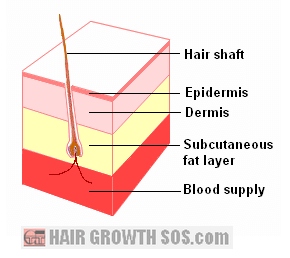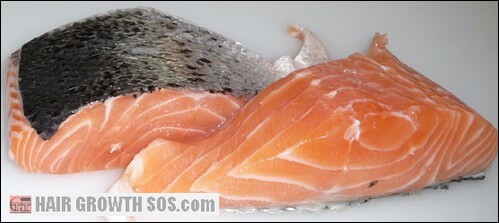Can Scalp Fat (Brown Fat) Save Your Hair?
By Paul Taylor
Increased brown fat
levels in the scalp might encourage healthy hair growth, and a lack of it might be linked
to hair loss.
Many factors can affect hair loss development. This article explains how brown scalp fat (subcutaneous fat) could be an important area of research in our quest to fully understand the hair loss process.
A Scalp Fat-Hair Loss Coincidence?

Brown fat (brown adipose tissue) is found deep down in the subcutaneous layer of the skin. It's often referred to as "baby fat" too because it comprises as much as 5% of the body weight in a newborn baby.
Brown adipose tissue levels decrease with age. But it's now known to be still present in adults. It's most abundant in younger women and much less so in older, overweight men (1).
So, basically this means that most men lack brown fat and do suffer
hair loss (androgenetic alopecia), whereas most women and children have higher brown fat levels and don't suffer hair loss.
I do not believe this is simply a coincidence.
The Science Behind This Idea
Research has shown that the follicles of vigorously growing scalp hair are embedded in a thick layer of adipose tissue, but there's a lack of adipose tissue around dormant follicles. So this suggests that adipose tissue serves a supportive role for hair follicles and hair growth (2).
It's been observed that, in cases of androgenetic alopecia, the bald areas are mostly depleted of fat tissue whereas, in the
lower rear (occipital) region where hair loss does not occur, a thick
layer of fat tissue is present.
I believe this type of hair loss develops due to skull bone growth (skull expansion), which progressively disrupts the capillary blood supply required by follicles to grow hair.
So it may well be that brown fat offers some resistance against this process.
And I believe there are two possible reasons for this:
1. Angiogenesis (vascularization).
2. Cushioning effect against the skull expansion process.
1. Angiogenesis (Vascularization)
Adipose tissue encourages angiogenesis (new blood vessel formation) (3)(4).
And that's important because hair undergoes a growth cycle. During the growing phase of this cycle, follicles continuously try to grow deep down into the dermis of the skin where they can receive an abundant supply of blood.
However, in those who suffer hair loss, this process is hindered by skull expansion.
So, if scalp fat levels can be increased, this might create new blood vessels and allow healthy hair to start growing again.
2. A Cushioning Effect
Given that a layer of adipose tissue will increase the
thickness of the dermis, it may provide a cushioning effect that can
reduce blood vessel constriction and increase scalp flexibility.
How Can You Increase Your Scalp Brown Fat Levels?
The omega 3 fish oils, EPA (eicosapentaenoic acid) and DHA (docosahexaenoic acids) along with other nutrients (capsaicin, resveratrol, curcumin, green tea, etc.) have been associated with the activation of brown fat activity (and browning of white adipose tissue) (5).
So it may well be that, by consuming certain foods, such as a very high omega 3 diet, you can do something to help your hair grow.
Perhaps the best evidence for this idea comes from the Inuit people (Eskimos) who consume extremely high levels of omega 3 fish oils from their diet, and have a very low incidence of androgenetic alopecia.
Learn about ethnicity and hair loss.
You might be able to increase your levels of brown adipose tissue from omega 3 fish oil supplements containing EPA and DHA. Otherwise, omega 3 can be obtained from eating oily fish such as salmon, mackerel, etc.
Vegetarian sources of omega 3 can be obtained from walnuts, pumpkin seeds, linseed (flax), etc.
Note: vegetarian
sources of omega 3 have to be converted to EPA and DHA by the body.

However, there is uncertainty as to how much omega 3 will get converted into BAT and then find it's way into your scalp.
So whilst diet might improve the growth of your hair, it's
sensible to try a number of ideas in your battle against baldness: the
hands-on techniques I successfully used to stimulate my own hair regrowth are now helping many
others to do the same: read reviews.
A Few More BAT Facts
- BAT (i.e., brown adipose tissue) serves as a heat insulator, shock absorber and provides energy for the body.
- BAT has the ability to produce heat without the need for shivering
and is of interest to scientists right now because it does this by
burning calories from normal fat (white adipose tissue). This means
that it may have an application in the weight loss industry.
- Recent research shows that BAT is related to skeletal muscle.
- BAT is brown because it is highly vascularized (i.e., it contains
blood vessels) and contains a large number of mitochondria (which
provide energy).
- Exposure to the cold will activate BAT activity.
- BAT may play a supportive role in successful hair transplants: learn more?
|
Like this page? |
|

